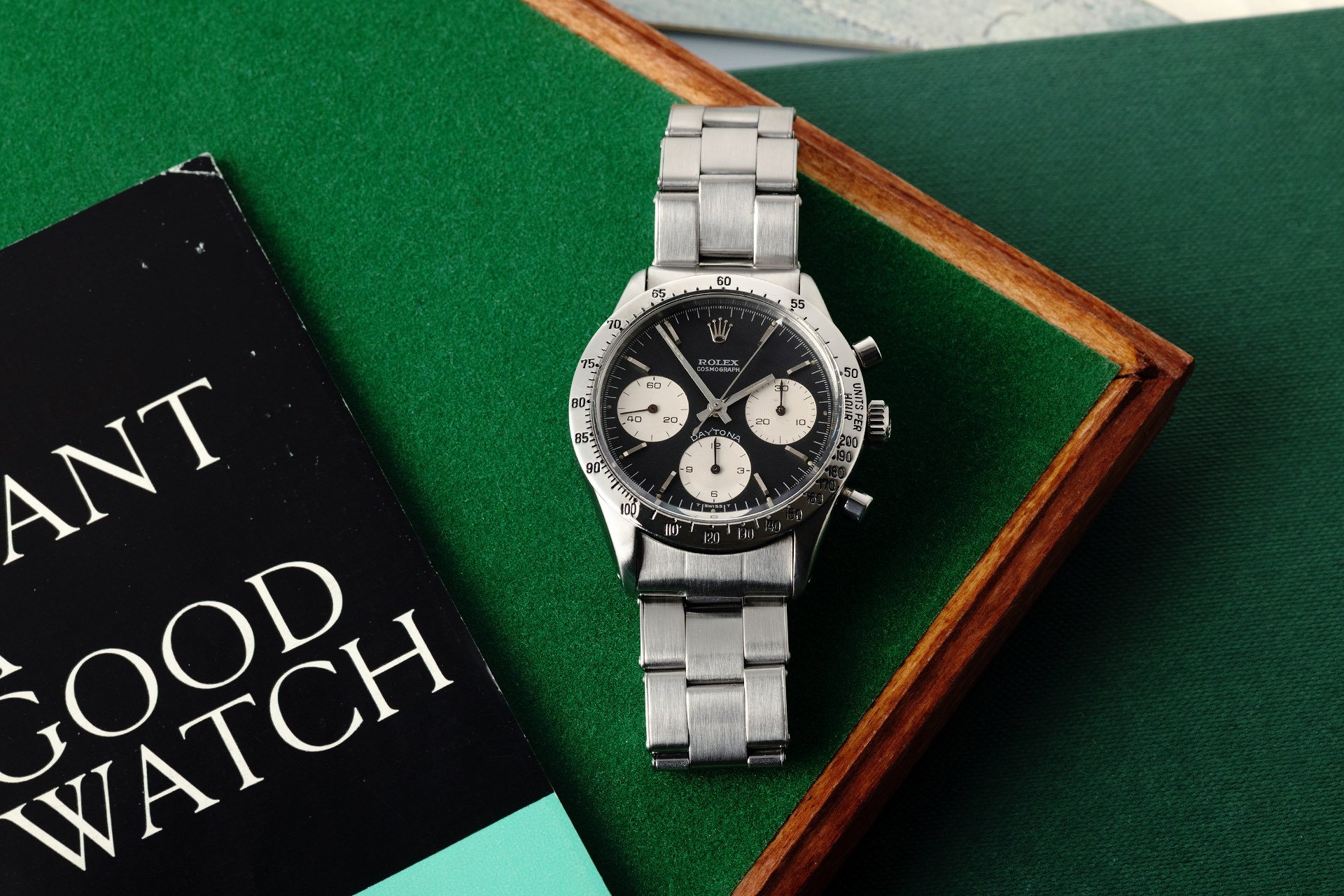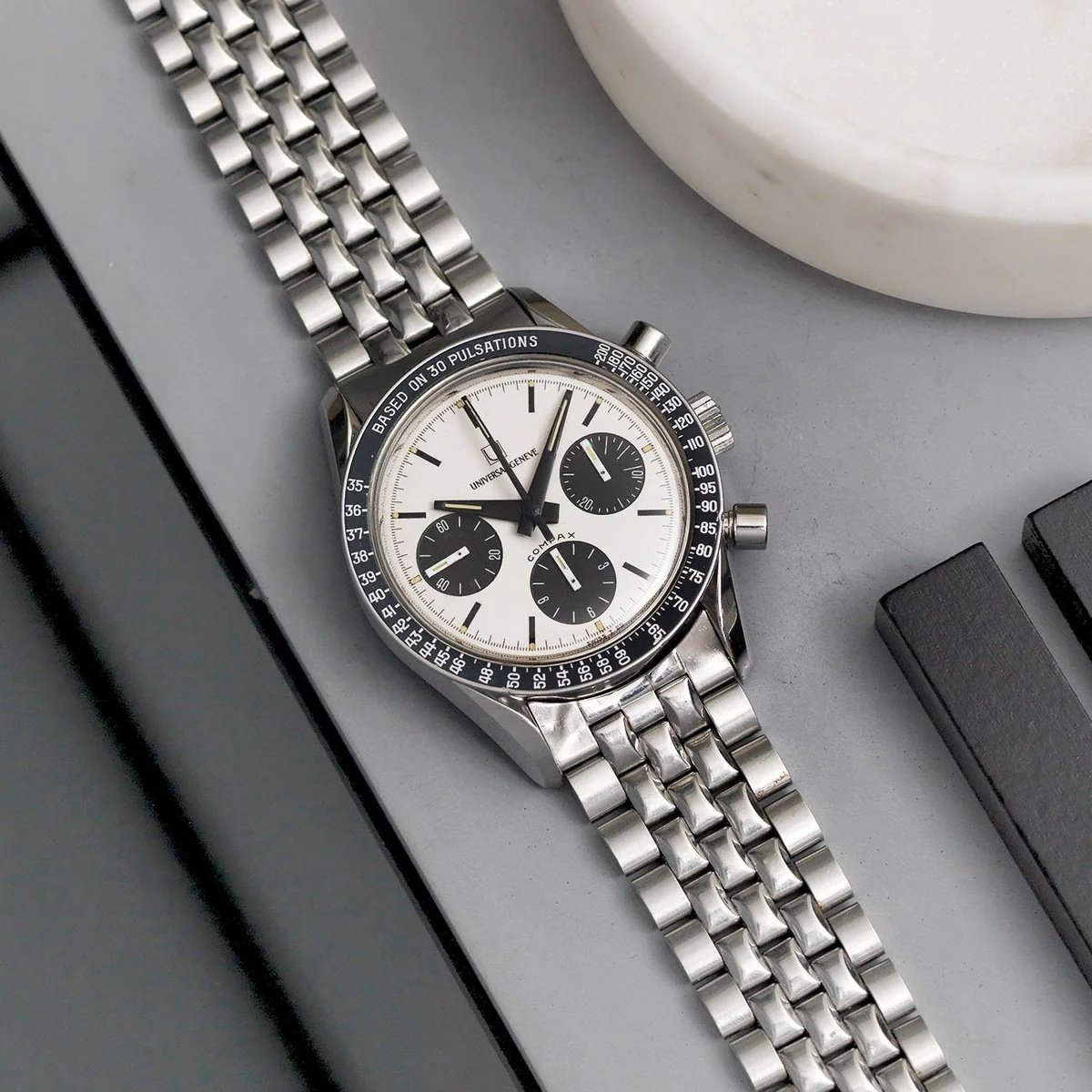It’s Friday again and so is our new list. This week we continue our quest for legendary movements. For this list, we have selected five classic watches equipped with the famous Valjoux 72. As you can see, this chronograph caliber was found in some of the most legendary timepieces that watch enthusiasts love. That’s why it makes sense to create a list of five outstanding watches equipped with Valjoux 72. Let’s check them out.
The history of the Valjoux 72 and the Valjoux 23 on which it is based is worthy of an article in itself. However, as we discuss the top 5 watches featuring this movement, let’s focus on a few quick facts. The Valjoux 23 debuted in 1916 and was a huge success for the movement manufacturer founded in 1901 by John and Charles Raymond. The Valjoux 23, or VZ23, is a two-register chronograph caliber that became the basis for many other movements over the following decades. The standard layout features a seconds hand at 9 o’clock and a 30- or 45-minute chronograph counter at 3 o’clock.
Image: Bulang & Sons
The Valjoux 72, born in 1938
In 1938, Valjoux added a 12-hour counter at 6 o’clock, and the Valjoux 72 was born. This new caliber also served as the base movement for a number of variations. Famous examples include the triple calendar Valjoux 72C and the Valjoux 88, which added a moon phase indicator. The Valjoux 72 was in production until the late 1960s, after which it underwent a notable update. The company increased the operating frequency from 18,000 to 21,600 beats per hour, creating the Valjoux 726. Over the decades, the Valjoux 23 and 72 became popular calibers in many fine chronographs. As you can see from this list, some very prestigious watchmakers used these movements in their famous chronographs, which is also why they are so desirable to collectors. So, without further ado, let’s take a look at five of our favorites.

Image: The Watch Club
Rolex Cosmograph Daytona
The watch that put the Valjoux 72 on the map was the Rolex Daytona. From the first model in 1963 to the last in the late 1980s, every manual Rolex Daytona was powered by the Valjoux 72B or a derivative. The first Daytona in 1963, Ref. 6239, featured a black dial with silver subdials. Interestingly, the first model did not bear the Daytona name.

Image: The Watch Club
Rolex originally called the watch “Le Mans”, but the name was deemed inadequate for conquering the American market, but the brand’s sponsorship of the Daytona 24 Hours solved the problem, and from 1964 the watch was called the Daytona.

Image: The Watch Club
Early Daytonas were equipped with the Valjoux 72B, but soon began using the Valjoux 722. With the introduction of the references 6262 and 6264 in 1969, Rolex also began using more modern movements: the Valjoux 727, used until the end of the 1980s, increased the operating frequency from 18,000 to 21,000 vibrations per hour.

Image: The Watch Club
As a result, the new movement was also significantly more accurate. Rolex improved the movement, replacing 15 parts, screws, and associated clamps. Overall, the Valjoux 72-derived movement powered the Daytona from 1963 to 1988, an astounding 25 years.

Image: Fred Mandelbaum
Breitling Navitimer “Pre-806”
In 1954, Breitling introduced the now-famous Navitimer as a high-performance pilot’s watch made for the Aircraft Owners and Pilots Association (AOPA). It was a year later that the watch became the official reference 806. Many of you will know that the Navitimer’s slide rule and three-register chronograph functions were inspired by the brand’s 1940s Chronomat reference 786. However, while that Chronomat was a 36mm watch, the 40mm Navitimer was considered huge at the time of its introduction. This was understandable, as the watch was intended to be easy to read and functional in the cockpit.

Image: Fred Mandelbaum
Early Navitimers from 1954 were equipped with a Valjoux 72 movement and are known as “Pre-806” models. These are extremely rare and, unsurprisingly, command top prices at auctions and sales. Just one year after the Navitimer was introduced, Breitling switched to the Venus 178 movement. Considering that production numbers back then were not as high as they are today, you can imagine how rare these early Valjoux 72-equipped Navitimers are. As such, they are becoming increasingly popular among collectors. Prices start at 20,000 euros in good condition and can rise quickly.

Image: Analog/Shift
Heuer Carrera ref. 2447
Speaking of Heuer, there are a number of models powered by the Valjoux 72 – the famous Autavia 2446M “Jochen Rindt” is a fine example, as is the incredible Camaro 7220 NT – but the one we chose is the legendary Heuer Carrera 2447, which marked the beginning of the Carrera tradition in 1963. The 2447 was in production until the late 1960s, during which time the brand created over 30 different versions.

Image: Bulang & Sons
So if you’re interested in these watches, it’s a good idea to do your research beforehand. Mike wrote a great article back in 2015 about the ref. 2447S he bought for his father. As you can see in the two images above, this is the original version with its crisp silver/white dial. Paired with the 36mm case, it’s hard to beat the super clean look.

Image: Analog/Shift
Many of you may also be familiar with the stunning Ref. 2447N, with its black dial, black registers, and white ring around the seconds track. I love this particular finish because it’s a super cool look that you rarely see. All Carrera 2447 variations made up until 1970 were powered by the Valjoux 72.

Image: Bulang & Sons
These beautiful first generation Carreras are well worth a look, and you’ll find them available nowadays for under €5,000, although, as always, a good one can easily command €10,000.

Image: Bulang & Sons
Universal Geneve Compax “Nina Rindt”
Another famous pairing of Valjoux 72-powered chronographs is the Universal Genève Compax “Nina Rindt” and Compax “Evil Nina”. Both are sports chronographs named after Nina Rindt, wife of famous Formula 1 racing driver Jochen Rindt. She often wore the panda dial version, gifted to her by her husband, on a large band strap.

Image: Bulang & Sons
This watch was produced between 1964 and 1967 and features a 36mm stainless steel case with beautiful lyre lugs. The brand produced the dial in two colors. The first is the version with reference number 885.103/2. Known as the “Nina Rindt,” this model features a white dial and black registers.

Image: Bulang & Sons
The second model, reference 885.103/1, is known as the “Evil Nina” and features a black dial and white registers. Additionally, the central chronograph hand is large and bright red, a nice touch. To the untrained eye, the Universal Genève Nina Rindt can look like a Rolex Daytona. That’s understandable, but there are some significant differences. You can tell right away by looking at the hands. Look at the tiny hands used for the registers on the white dial version. They look too angular for the size of the subdials. The hands on the registers of the Evil Nina model are much more refined.

Image: Bulang & Sons
Universal Geneve produced a variety of bezels for these watches, including tachymeter and pulsometer variations. Of course, the watches were powered by the famous Valjoux 72 movement with its famous three-register layout. If you want to know more, I recommend reading Mike’s in-depth article on the Evil Nina. As these are rare watches, expect prices to start at around 15,000 euros and easily rise to 20,000 euros.

Enicar Sherpa Graf
Finally, we have the Enicar Sherpa Graph. This is another legendary chronograph that is fun to read about – Mike owns the “Jim Clark” version (see above) and wrote a great article about it back in 2015 which you should definitely read. The Sherpa Graff debuted in 1960 and was in production for 10 years, during which the legendary brand produced several versions of the watch with different dial colors.

Image: Bulang & Sons
Additionally, the style of the hands has also changed over the years to suit the times. What these watches have in common is a very stylish presence, defined by their beautiful 40mm cases and beautifully designed dials in a range of colors.

Image: Bulang & Sons
I love the grey dial version on the white Tropic strap worn by Jim Clark. Several famous racing drivers wore Enicar watches, including Stirling Moss, Erik Karlsson and Gerhard Mitter. Mike’s “Jim Clark” version has a beautiful black dial with a black-on-white printed tachymeter and thin hour and minute hands with wide rectangular lume plots. Stirling Moss was the brand’s driver in an early advertisement for the Sherpagraph Mk1, which had the distinctive sword-shaped hands.

Image: Bulang & Sons
Inside the 40mm case, naturally, is the Valjoux 72 that powers every other watch on this list. This Enicar Sherpa Graph is a rare watch, so expect to pay a lot, especially the Mk1 version. Prices for later versions start at around 6,500 Euros, while earlier examples in good condition can sell for 15,000 Euros. In return, you’ll get one of the most stylish chronographs ever made, powered by the legendary Valjoux 72 movement.

Image: Bulang & Sons
Final Thoughts on the List of Valjoux 72-Powered Classics
We have introduced five watches equipped with the legendary Valjoux 72. As you may know, this is just the tip of the iceberg. Watches from famous brands such as Longines, Audemars Piguet, Patek Philippe, Vacheron Constantin, and Jaeger-LeCoultre are also equipped with movements based on the Valjoux 23 and 72 calibers. It would be fun to explore more watches beyond the five we have selected, but we like all five watches we have chosen today. And we want to know which one you like best as much as we do. Let us know your favorite in the comments. See you again next week with a new list.
Featured Image: The Watch Club
![[F]Fratello’s Top 5 Classic Valjoux 72 Watches [f]fratello's Top 5 Classic Valjoux 72 Watches](https://bellamywatches.com/wp-content/uploads/2024/09/FFratellos-Top-5-Classic-Valjoux-72-Watches-768x512.jpeg)